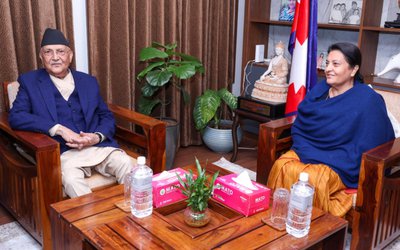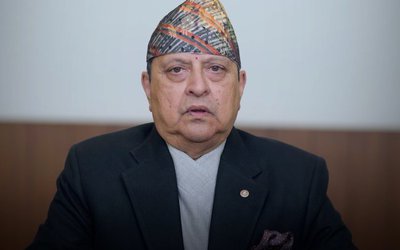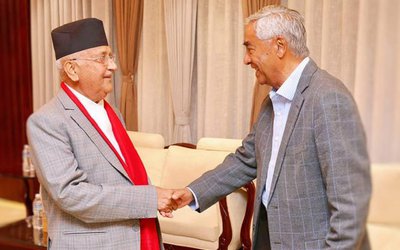
On June 10, Nepal’s House of Representatives unanimously approved the tabling of an amendment to the country’s constitution which will now formally depict nearly 400 sq km of Indian territory extending west from the Lipulekh Pass, and including it, as part of Nepal’s sovereign territory. While it remains to be passed by the Upper House and signed by the president, the die has been cast. In doing so, Nepal has etched its territorial claim in stone which would make any concession by this or any future government of Nepal virtually unthinkable.
After the vote, Nepal’s Foreign Minister Pradeep Kumar Gyawali declared: “We are for starting dialogue soon. The problem will be resolved through diplomacy.” Short of expecting India to accept the fait accompli determined unilaterally by Nepal, what will diplomacy achieve? India should be prepared to engage in a dialogue on this and other outstanding border issues, but Nepal’s brinkmanship has made it much more difficult to explore a mutually acceptable solution. Gyawali said that the dialogue will be carried out “on the basis of historical facts”. Perhaps that offers an opening although I doubt that any “facts” contrary to what have been adduced by the Nepali side will be countenanced. But let us review the “historical facts”.The Indian Express
One, Nepal bases its claim to the additional territory now included in its official map on the Anglo-Nepal Treaty of Sugauli of 1816, which determined the Kali river as the western boundary between British India and Nepal. An East India Company map has been produced from the archives to show that the British considered the tributary of the Kali River, the Limpiyadhura, as its main channel. But a map drawn up in 1879 after surveys had been carried out shows the boundary along a ridge just west of the Tinker Pass. As per this and later official British maps and what India claims, Kali River originates from a natural spring at Kalapani, where it is joined by a rivulet flowing down from Lipulekh Pass. This was not challenged then nor at any time subsequently until after 1990. In fact, Nepali maps have all along reflected the same alignment. Some Nepali journalists and scholars now argue that the monarchy, first under King Mahendra and later under King Birendra, was reluctant to raise this issue with India for fear of Indian reaction. This is laughable as both the monarchs thrived on a diet of anti-Indian nationalism.
Two, India had, in the early 1950s, set up, with the consent of Nepal, a string of military-cum-police posts along the Nepal-China border after the Chinese occupied Tibet. There were either 17 or 18 posts altogether and they remained in place until 1969. In that year, Kirti Nidhi Bisht, the Nepali Prime Minister, on the instructions of King Mahendra, asked Indira Gandhi to withdraw all these posts from Nepali territory. This was done but the Indian post at Kalapani was not in the Nepali list. When this is pointed out, the answer is that Mahendra was being sensitive to India’s security concerns vis-a-vis China and hence allowed an act of generosity to let India hold on to Kalapani and access to Lipulekh Pass.
Again, is this really believable? In 1969, China was in the thick of the Cultural Revolution. There was limited activity on the India-China border. The central sector where Kalapani lies and north of it, the pass itself, was the least disputed sector. Why would India plead for Mahendra’s generosity? When I was India’s ambassador in Nepal, Kirti Nidhi Bisht told me that one of the proudest moments in his life was when he “stood down” Indira Gandhi and compelled her to withdraw each and every military post from Nepal’s territory. He did not mention then that the Indian posts at Kalapani and at Lipulekh Pass continued to be on Nepali territory. To be fair, he did so later before his death in 2017.
Three, China and Nepal reached a border agreement in 1961. Article 1 in the agreement describes the western extremity of the China-Nepal border and this conforms to the alignment claimed by India. The Chinese-Nepalese border starts from the point where the watershed between the Kali River and the Tinker River meets the watershed between the tributaries of the Mapchu(Karnali) River on the one hand and the Tinker River on the other, thence it runs south-eastward along the watershed.
One should note the word “starts” which is important in view of what follows. In subsequent demarcation, Pillar No 1, which marks this starting point at the western extremity, is located at Tinker Pass, well east of Lipulekh Pass. This cannot be refuted as this is in the formal documents. Buddhi Narayan Shrestha, who has been responsible for putting out justification for the new claims against India, is unable to deny it either. But he now says that the trijunction at this end has not been determined and that notionally it would be pillar number zero on the boundary! This is the first time one has heard of the concept of a “number zero border pillar”! This is ex post facto justification and the dishonesty behind it is glaring. A Nepali diplomat has repeated this same specious argument,
“Given the situation in 1961, Nepal and China fixed pillar No 1 at Tinker Pass with the understanding that pillar number zero (trijunction of Nepal, India and China) would be fixed later.” He has not adduced any evidence that this indeed was the “understanding” reached with China in 1961.
Four, India and China concluded an agreement in 1954 for trade and transit between India and Tibet and among the six border passes listed for the purpose, Lipulekh was included. There was no protest from the Nepali side. The first time that Nepal protested formally was in 2015 when India and China signed an MoU for conducting border trade between the two countries through Lipulekh Pass.
If facts are to be the basis for an eventual solution one hopes that they would not be used selectively. India-Nepal relations are far too important to be derailed by this unfortunate display of cynical brinkmanship by Nepal’s short-sighted leaders. India will need to tread carefully. While it should stand its ground on the territorial issue, it should be willing to look at ways in which Nepali sentiments could be assuaged. One could convey to Nepal that it may have privileged access to the Kalapani area for trade or pilgrimage. Nepali citizens may be permitted to use any infrastructure created in this or other border areas for easier access from one part of Nepal to another.
Most importantly, the Narendra Modi government needs to shed its fond expectation that Nepal’s affinity with India because of its Hindu heritage is sufficient to consolidate political relations with that country. Neither is that shared heritage sufficient to prevent Nepal’s penchant to wave the China card in India’s face whenever it seeks to advance its own interests. And putting all eggs in the Oli basket, and in the bargain alienating other important political constituencies over the recent past, has proved to be costly.
The writer is a former foreign secretary and is senior fellow CPR. He was India’s ambassador to Nepal 2002-04
Source: The Indian Express

Shyam Saran
The writer is a former foreign secretary and senior fellow CPR. He was India’s ambassador to Nepal 2002-4.
- Unfolding Crisis In Nepal
- Dec 31, 2020
- India, Nepal Must Seek Mutually Acceptable Solutions To Controversy Over New Map
- Nov 27, 2019














